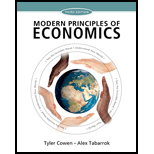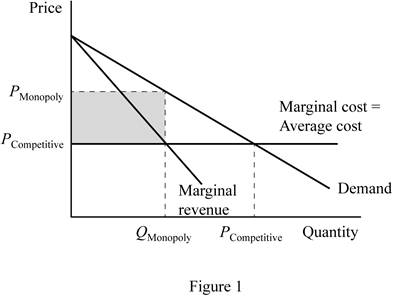
Subpart (a):
The lure of the cartels.
Subpart (a):
Explanation of Solution
The market is a structure where there are buyers who buy and sellers who sell and there is an exchange of goods and services between them. The
The profit of a firm is the excess revenue left with the firm after deducting the total cost of production from the total revenue of the firm that is generated through the sale of the goods and services. Here, in the case of the firm, the case is

Here, the monopoly price is higher than the competitive price; this means that the firm earns higher than the marginal cost and the average cost (which is the profit per unit). When it is multiplied with the monopoly quantity, it gives us the profit of the monopolist.
Concept introduction:
Cartel: A cartel is an association or organization of suppliers or producers, which has the main intention of keeping the prices of the commodities that they produce high and reducing the competition between them.
Market: The market is a structure where there are buyers who buy and sellers who sell and there is an exchange of goods and services between them. The price is determined by the interaction of demand and supply in the market.
Subpart (b):
The lure of the cartels.
Subpart (b):
Explanation of Solution
When the size of the monopoly profit has to be calculated, the area can be calculated by subtracting the average cost of the firm (which is also equal to the marginal cost) and competitive price from the monopoly price, and multiplying it with the monopoly quantity. It is the area of the monopoly profit which can be explained in the following formula:
Concept introduction:
Cartel: A cartel is an association or organization of suppliers or producers, which has the main intention of keeping the prices of the commodities that they produce high and reducing the competition between them.
Market: The market is a structure where there are buyers who buy and sellers who sell and there is an exchange of goods and services between them. The price is determined by the interaction of demand and supply in the market.
Subpart (c):
The lure of the cartels.
Subpart (c):
Explanation of Solution
It is given that the monopoly price is equal to $0.70/lb and the marginal cost of production (which is equal to the average cost of production and the competitive price) is $0.40/lb. The monopoly quantity demanded is given as 300 million lb. Thus, the monopoly profit per unit can be calculated by subtracting the average cost from the monopoly price as follows:
Thus, the monopoly profit per unit is $0.30/lb. Similarly, the total industry profit can be calculated by multiplying the monopoly per unit profit with the total monopoly quantity demanded as follows:
Thus, the total industry profit is equal to $90,000,000.
Concept introduction:
Cartel: A cartel is an association or organization of suppliers or producers, which has the main intention of keeping the prices of the commodities that they produce high and reducing the competition between them.
Market: The market is a structure where there are buyers who buy and sellers who sell and there is an exchange of goods and services between them. The price is determined by the interaction of demand and supply in the market.
Subpart (d):
The lure of the cartels.
Subpart (d):
Explanation of Solution
When the monopoly market is in operation, each producer earns $0.30/lb of apples. When everything remains the same and one single producer cheats the cartel by increasing the production by 1,000,000 pounds of apples, it will increase the profit of the producer. This can be calculated by multiplying the per-unit profit with the increased quantity as follows:
Thus, the cheating producer earns approximately $300,000 additionally, through cheating. The extra profit made is approximate because the increase in the quantity will push the prices down in the market. Since the increase in the quantity is only 1/300th of the market, the impact on the price would be lower.
Concept introduction:
Cartel: A cartel is an association or organization of suppliers or producers, which has the main intention of keeping the prices of the commodities that they produce high and reducing the competition between them.
Market: The market is a structure where there are buyers who buy and sellers who sell and there is an exchange of goods and services between them. The price is determined by the interaction of demand and supply in the market.
Want to see more full solutions like this?
Chapter 15 Solutions
Modern Principles of Economics
- 17. Given that C=$700+0.8Y, I=$300, G=$600, what is Y if Y=C+I+G?arrow_forwardUse the Feynman technique throughout. Assume that you’re explaining the answer to someone who doesn’t know the topic at all. Write explanation in paragraphs and if you use currency use USD currency: 10. What is the mechanism or process that allows the expenditure multiplier to “work” in theKeynesian Cross Model? Explain and show both mathematically and graphically. What isthe underpinning assumption for the process to transpire?arrow_forwardUse the Feynman technique throughout. Assume that you’reexplaining the answer to someone who doesn’t know the topic at all. Write it all in paragraphs: 2. Give an overview of the equation of exchange (EoE) as used by Classical Theory. Now,carefully explain each variable in the EoE. What is meant by the “quantity theory of money”and how is it different from or the same as the equation of exchange?arrow_forward
- Zbsbwhjw8272:shbwhahwh Zbsbwhjw8272:shbwhahwh Zbsbwhjw8272:shbwhahwhZbsbwhjw8272:shbwhahwhZbsbwhjw8272:shbwhahwharrow_forwardUse the Feynman technique throughout. Assume that you’re explaining the answer to someone who doesn’t know the topic at all:arrow_forwardUse the Feynman technique throughout. Assume that you’reexplaining the answer to someone who doesn’t know the topic at all: 4. Draw a Keynesian AD curve in P – Y space and list the shift factors that will shift theKeynesian AD curve upward and to the right. Draw a separate Classical AD curve in P – Yspace and list the shift factors that will shift the Classical AD curve upward and to the right.arrow_forward
- Use the Feynman technique throughout. Assume that you’re explaining the answer to someone who doesn’t know the topic at all: 10. What is the mechanism or process that allows the expenditure multiplier to “work” in theKeynesian Cross Model? Explain and show both mathematically and graphically. What isthe underpinning assumption for the process to transpire?arrow_forwardUse the Feynman technique throughout. Assume that you’re explaining the answer to someone who doesn’t know the topic at all: 15. How is the Keynesian expenditure multiplier implicit in the Keynesian version of the AD/ASmodel? Explain and show mathematically. (note: this is a tough one)arrow_forwardUse the Feynman technique throughout. Assume that you’re explaining the answer to someone who doesn’t know the topic at all: 13. What would happen to the net exports function in Europe and the US respectively if thedemand for dollars rises worldwide? Explain why.arrow_forward

 Principles of Economics (12th Edition)EconomicsISBN:9780134078779Author:Karl E. Case, Ray C. Fair, Sharon E. OsterPublisher:PEARSON
Principles of Economics (12th Edition)EconomicsISBN:9780134078779Author:Karl E. Case, Ray C. Fair, Sharon E. OsterPublisher:PEARSON Engineering Economy (17th Edition)EconomicsISBN:9780134870069Author:William G. Sullivan, Elin M. Wicks, C. Patrick KoellingPublisher:PEARSON
Engineering Economy (17th Edition)EconomicsISBN:9780134870069Author:William G. Sullivan, Elin M. Wicks, C. Patrick KoellingPublisher:PEARSON Principles of Economics (MindTap Course List)EconomicsISBN:9781305585126Author:N. Gregory MankiwPublisher:Cengage Learning
Principles of Economics (MindTap Course List)EconomicsISBN:9781305585126Author:N. Gregory MankiwPublisher:Cengage Learning Managerial Economics: A Problem Solving ApproachEconomicsISBN:9781337106665Author:Luke M. Froeb, Brian T. McCann, Michael R. Ward, Mike ShorPublisher:Cengage Learning
Managerial Economics: A Problem Solving ApproachEconomicsISBN:9781337106665Author:Luke M. Froeb, Brian T. McCann, Michael R. Ward, Mike ShorPublisher:Cengage Learning Managerial Economics & Business Strategy (Mcgraw-...EconomicsISBN:9781259290619Author:Michael Baye, Jeff PrincePublisher:McGraw-Hill Education
Managerial Economics & Business Strategy (Mcgraw-...EconomicsISBN:9781259290619Author:Michael Baye, Jeff PrincePublisher:McGraw-Hill Education





